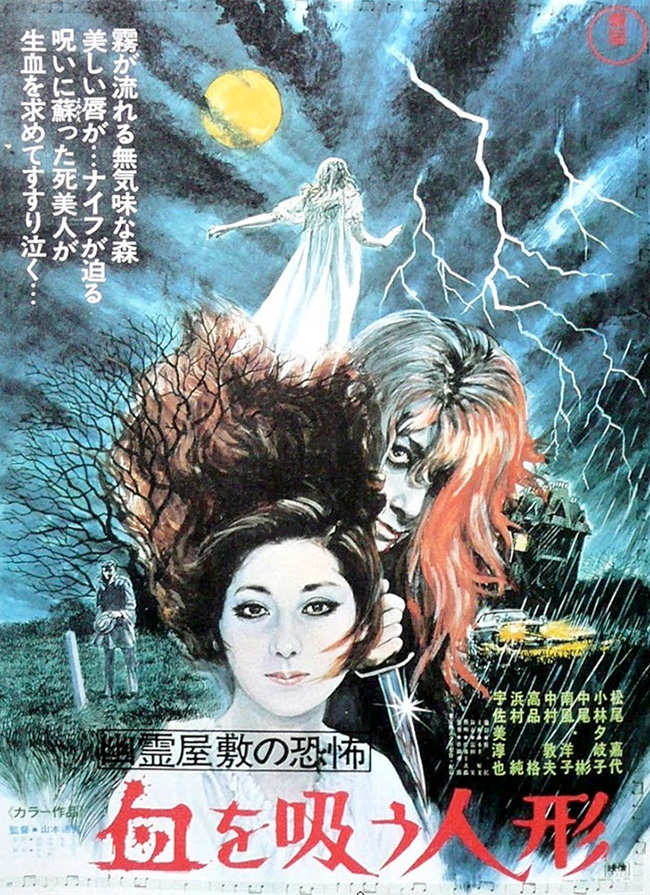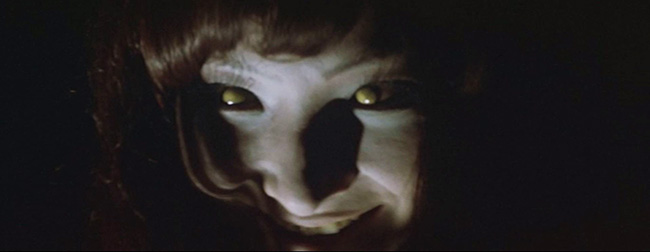
In Japan in the early 70’s, Toho made a brief, intriguing attempt to emulate the Gothic horror of the West, an effort kicked off by The Vampire Doll (aka Fear of the Ghost House: Bloodsucking Doll, 1970). This vampire film did not feature the traditional hopping vampires, or kyonshī in the Japanese (after the Chinese spirits called jiangshi). Instead, The Vampire Doll was explicitly influenced by the vampire films and psychological thrillers of Hammer, the Gothics of Roger Corman, and the jolting Italian shockers of Mario Bava, with just a dash of Rosemary’s Baby (1968), and a good heaping portion of Psycho (1960). All of this crammed into 70 minutes. The director was Michio Yamamoto, who would go on to direct Lake of Dracula (1971) and Evil of Dracula (1974), at one point packaged together on DVD as the “Bloodthirsty Trilogy.” Yet even wearing its influences on its bloody sleeve, The Vampire Doll is distinctly Japanese, for its hodgepodge of elements all ultimately contribute to a familiar Japanese ghost story about a resurrected female spirit who takes lives as payment for a sexual crime buried in the past (see also Kuroneko), and with characters reeling from the destruction of World War II (see also Godzilla). At one point, the film even stops for one veteran to recount a ghost story from the battlefield, and it is the war which ultimately is key to unlocking the film’s mystery and its tragic backstory.
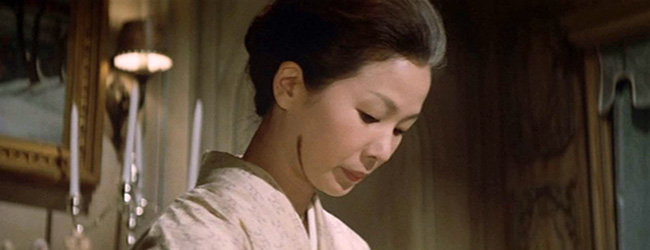
Mrs. Nonomura (Yoko Minakaze) and her mysterious scar.
The opening certainly kicks the Gothic into high gear with a taxi ride through a thunderstorm, rain beating against the windshield, the passenger, a young man named Kazuhiko Sagawa (Atsuo Nakamura, Kill!), looking anxiously at the box in his hand, a present for his lover Yuko Nonomura (Yukiko Kobayashi, Destroy All Monsters), whom he hasn’t seen for 6 months. It might as well be a carriage ride up the mountains toward Dracula’s castle, but the destination, when it’s finally seen beneath flashing lightning, is a modern villa nestled against a forest. The fact that the home does not resemble the Japanese style is explained with a brief, throwaway statement that it was built for a diplomat in the Nonomura family. At the door Kazuhiko is greeted by the glowering Genzo (Kaku Takashina, Story of a Prostitute), who is hard of hearing and “dumb” – and, as we shall come to see, absurdly quick to violence – therefore filling that stock role required by so many Gothic horrors. The woman of the house is Mrs. Nonomura (Yoko Minakaze, Kubi), who bears a mysterious crescent shaped scar along the side of her neck. She informs Kazuhiko that her daughter Yuko was recently killed: she was in a car accident, her car crushed in a landslide caused by a storm. The distraught Kazuhiko spends the night in the Nonomura home, opening his gift to reveal a wooden doll (naturally, Yuko collected creepy dolls – her bedroom is full of them). At night he hears a soft weeping, and follows the noise down the hall. He looks through a keyhole into Yuko’s room and sees a shape moving the rocking chair – then it’s gone. He enters the room, explores, and eventually opens the closet. We see Yuko, her eyes gleaming strangely, and then he’s knocked unconscious – by Genzo, presumably. Later Kazuhiko has the opportunity to visit Yuko’s grave, and he sees Yuko again. She’s crying and begs him to kill her. As he embraces Yuko, we see, over his shoulder, the girl’s eyes beginning to glow. She lifts a bloody arm, and we glimpse a knife in her hand…
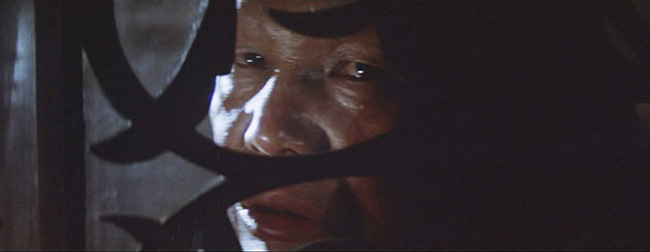
Kaku Takashina as the manservant Genzo.
The story abruptly shifts to Kazuhiko’s sister, Keiko Sagawa (Kayo Matsuo, Shogun Assassin), who wakes up as though everything we’ve just seen is a dream. (Luckily, that’s not the case.) With her fiancé Hiroshi (Akira Nakao, Only on Mondays) she decides to investigate her brother’s disappearance by driving out to the Nonomura residence. The structure, therefore, follows that of Psycho – our protagonist has been abruptly killed, and a couple play amateur detectives to find out what happened. They stay with the Nonomuras, who plead ignorance as to Kazuhiko’s fate, but Keiko and Hiroshi also take the time (as with Psycho) to speak with some local authorities to uncover the history of the house, which has been “cursed by the God of Death.” Many years ago, following the war, someone broke into the Nonomura home and shot to death everyone but Mrs. Nonomura and Genzo. She was raped, and Yuko was born nine months later. Mrs. Nonomura attempted suicide – thus the scar. As Keiko and Hiroshi poke around the home late at night, they overhear the strange weeping, and Keiko encounters Yuko, with her glowing eyes and bloody arm – who retreats at a light that shines into her face. Director Yamamoto makes excellent use of jump scares, such as when Hiroshi exhumes Yuko’s grave and a body jolts upward – a life-size doll (why someone went to the trouble of making the mannequin jump, like a prop in a funhouse, is left unanswered). When the body of Keiko’s brother is found, it’s in the basement, seated at a chair, back to the camera, so that it must be spun toward us to see the corpse’s face – a la the final reveal of Norman Bates’ mother. The appearances of Yuko are very effectively handled, as she suddenly appears in the corner of the elongated widescreen, and Yamamoto uses quick edits to close-up to heighten the shock. Other more conventional scares include a rat dropping onto Keiko (for no good reason) and bats flying through the frame.
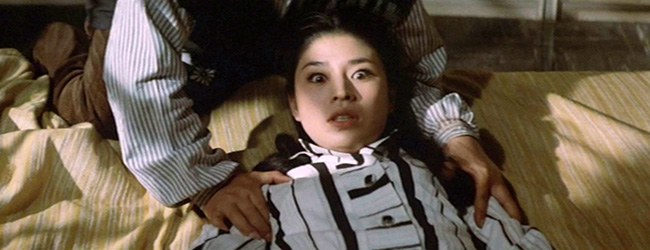
Keiko (Kayo Matsuo) is held down by Genzo while Dr. Yamaguchi approaches her with a hypodermic needle.
The village doctor, Dr. Yamaguchi (Jun Usami, of Ozu’s Late Spring – this is his last film credit), expresses a casual interest in the occult when he’s interviewed by Keiko and Hiroshi, but gradually he moves to the center of the film as a sinister suspect. In one scene reminiscent of Polanski, Keiko is restrained while Yamaguchi, insisting the girl is hysterical and must be sedated, threatens her with a hypodermic needle. We also learn that the doctor, who has secret ties to the Nonomura family, is a master of hypnotism, and that this power may have something to do with the reanimated Yuko. In one flashback, Mrs. Nonomura explains she believes she sold Yuko’s soul to the devil – “the devil began to whisper to me,” she says. It’s even conjectured that Yuko marks the neck not out of a vampire’s bite, but to mimic (or mock) her mother’s scar. While this mystery unfolds, Hiroshi’s investigations lead to a battle with an axe-wielding Genzo at the edge of a cliff. As I said, it’s an action-packed 70 minutes. It all comes to a satisfying (if somewhat confusing) ending, the Gothic elements colliding with one another like some Japanese installment of Dark Shadows. But what stands out the most is the “vampire” Yuko, with her pale skin, golden contact lenses, and wicked smile, dolled up in her blue dress – very reminiscent of Bava’s ghost in Kill, Baby, Kill (1966) and Fellini’s similar ghost girl in the “Toby Dammit” episode of Spirits of the Dead (1968). In the film’s final moment of violence, she slashes a throat with a knife, and what erupts is a geyser-spray of blood straight out of a Hong Kong martial arts film. When the life finally slips out of her dead body, her hand, resting on the floor, deflates like Christopher Lee’s in Dracula (1958). Is this truly a vampire film, or just Yamamoto’s tribute to all the films he loved to watch?
